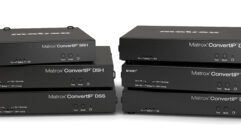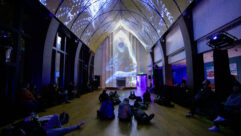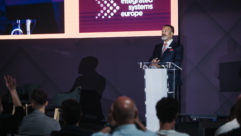
Modern Government AV, Part 1
Mar 12, 2013 11:13 AM,
WIth Bennett Liles
Listen to the Podcasts

Editor’s note: For your convenience, this transcription of the podcast includes timestamps. If you are listening to the podcast and reading its accompanying transcription, you can use the timestamps to jump to any part of the audio podcast by simply dragging the slider on the podcast to the time indicated in the transcription.
An old Wapakoneta, Ohio courthouse with a complete interior renovation called for preserving the character of the building while introducing some very modern sound system technology. The county called in RG Sound and Communications. Shawn Snider is going to tell us how it all went in and turned out, coming up right now on the SVC Podcast.
SVC: Shawn, thanks for being here with us on the SVC Podcast from RG Sound and Communications in Celina, Ohio, and it looks like you had a big courthouse installation in the, how do you pronounce that one, Auglaize County?
Shawn Snider: That’s correct, yeah, Auglaize County Courthouse.
In Wapakoneta, Ohio. That name rings a bell. Isn’t that the home town of Neil Armstrong?
It is. It is, indeed. They actually have a pretty significant memorial to him in a museum with some pretty cool stuff. [Timestamp: 1:16]
I’ll be they do. They probably have stuff to him all over the place.
Yep. Yep, they sure do.
So this courthouse project was part of a complete renovation, but before we get into that, let me ask you about RG Sound and Communications. What sort of an outfit is that and what types of projects do you take on?
RG Sound has been around for a very long time, and I became intertwined with them when they built a house next to my parents’ when I was pretty young. I started doing some odd jobs for them when I was about 14, and now that I’m 27 I’ve been there a while. I would say they’re a small boutique sound shop. We specialize in a lot of things throughout the years. The R stands for Ralph and the G stands for Godwin, which was the founder. After World War II he came back from the war as an RF Specialist. He specialized in radio broadcast and he claims he was the first one to broadcast back from the Philippians across the ocean. So he originally was into all the RF industries, as far as two-way radios for police and fire, and one of his specialties were county fairs. That’s one of the way we got a start there, and we noticed that all these county fairs that needed two-way radios, their sound systems were pretty lacking. So he decided why don’t we just add that division to our company and he did. And that’s how we got started with the sound industry there. He started as kind of a boutique-specialized outfit, and today we still are the same thing. Our projects kind of consist of small, very specialized projects. We try to take on the things that other people kind of stay away from. We like the challenge, and that’s something that’s always just been a part of the company there, ever since I can remember anyways. [Timestamp: 3:02]
Well, this looks like a big job because from what I’ve read on it, it looks like they just tore the whole inside of the place out and started over.
Yeah, pretty much. Essentially that is what they did.
And what was going on there that they needed your expertise?
Well, just like you said. They were kind of starting over. It was a very old building, very outdated in many aspects, and they wanted a full update from just appearance to audio/visual. I think they got a whole new server room and racks and stacks. It was pretty significant. They got ahold of us because they kind of had a problem, and that problem was they needed audio and video to be displayed in matrix throughout the building and they needed that to be remote controlled from a closet that had no access. And there are a lot of companies that make remote controls out there, but the problem here was that everything was prewired from the architect so we had definite limitations here going into the project. [Timestamp: 3:57]
OK and did they just schedule around your work in one courtroom at a time or how long did all of this take? You had three courtrooms, right?
That’s correct. Yeah, they actually shut the entire courthouse down for quite a while, if I remember correctly. Now then, by the time they got to us in the AV bidding process, a lot of the courthouse had already been refinished. They set up a temporary courthouse in the municipal building next door, which was very nice. You know, we could go in essentially any time 8:00 to 5:00, or beyond if the night staff was there, and do our work and complete it. As far as time per room, it was pretty quick. I spent a lot of time researching projects that I felt would be a good fit, and when you find the right product you know because it just kind of fits in pretty seamless and you don’t have a whole lot of man hours in it. [Timestamp: 4:44]
So what did you do first when you got in there? What was your first step? Did you have to take the old sound system out or was that already done?
That was already done. Everything had been refinished. All the wiring had been done. The first step was actually to spec the room so the bidding process could begin. That’s kind of how our relationship began. They asked us to come and sort of create a list of things that they would need to accomplish their goals and then release that to the public, and then ultimately it would be bid on. And we did bid on that as well, and won the bid, which is how we then proceeded to the next step of installation. [Timestamp: 5:18]
And obviously one of the things of prime importance to them was the flexibility of the system to be able to accommodate and interface with any new gear coming down the line in the future as part of say, future expansions, renovations, or upgrades. What did you do to insure the future adaptability of this thing?
Right, yeah, that was very important, you know, because these updates to these buildings don’t happen very often and that was one of the things they stressed a whole lot. So what we decided to do is go with a couple of innovative products and something kind of new, non-traditional, and that is to incorporate a lot of networked processors. When I say a lot, I mean two per room. There’s only two processors that run the whole room. The first one, we went with the Ashly Protea-equipped Amplifiers. And basically what those are is an 8-channel amplifier combo unit. It’s two rack space and it has your eight inputs, it has your eight channels of amplifier output that you can bridge if you want to. Within the software, that can be networkable. That was one of the big points is that the technician, I should say the person that runs everything there, the person that manages all of the electronics. [Timestamp: 6:33]
Modern Government AV, Part 1
Mar 12, 2013 11:13 AM,
WIth Bennett Liles
The tech guy!
The tech guy, yeah. His name is Cameron Rupert, by the way. He’s a really great guy and played an integral part in making this a success. He wanted to have access from all three of these rooms kind of quickly, you know? If they’re in the middle of a court proceeding and they need to put something up on the audio or the video system and there’s a problem, it would be great for him not to interrupt the courtroom and kind of barge in there and open up the rack and, you know, look for everything. He wanted something that could be accessible from anywhere. [Timestamp: 7:05]
And they’ve got some very high stakes things going on when they’re in business there.
Yeah, absolutely. So the Ashly you can put on the local network there and access all of the features remotely, which was just a stellar point for him in that he could literally sit in his server room and pull up those specs and change what he needed to change. The other way that these amplifiers made this very future-proof for the courthouse is that we left, I think, a total of, let’s see six extra outputs. So if they wanted to add speakers in the future or if they wanted to add any sort of other recording devices they could certainly do that, as well as inputs for utilizing two or, I think maybe three at this point, inputs out of the eight, so they have plenty of room to grow. The other great thing about the Ashly that made this a perfect fit is its matrixing capability. So you go in there with your eight inputs and your eight outputs and you can matrix those together in any order you want in real time. That was certainly a bonus for them. [Timestamp: 8:08]
So it’s just basically reprogramming. If they come up with a modification or add a room somewhere it’s just a matter of adding the local hardware and reprogramming the existing system.
Yeah, exactly. The other great feature too, which is pretty important, is the automix. You get the witnesses that go in there that testify that might be a bit soft-spoken, and that obviously has to be compensated for. The amplifier is intelligent enough that it will compensate that immediately. You can set it for delayed. Tthere’s all sorts of different ways you can approach that, as well as audio EQing. It learns over a period of time, in their case I would set for a week, so over the course of a week it will learn what frequencies are hot in the room and slowly eliminate those until it sort of tunes itself. [Timestamp: 8:53]
What do they use for mics in there? What type of mics do they use? Do they have area mics or do they actually put mics on people or use desk mics?
Yep, they’ve got some of the Audio-Technica mini desk mics there, those little condensers. They have them on every desk, the witness stand, the judge’s stand, and those are all fed into a, I call it the black box. It’s sort of a government-certified recording device that every time it’s turned on it’s recording in sort of an off-location site that’s backed up to the server. And it’s government certified. We couldn’t mess with it. All we know is we had an RCA out to work with. [Timestamp: 9:29]
Ah, well, that sort of narrows down all the possibilities when you’ve only got one little connector to attach everything to.
Right. Exactly. And that was also very tricky because that box controls the gain and phantom power of the microphones, so we definitely needed a processor in there that would be reactive. You know, if someone would change the gain in the black box, we would need the amplifier to react immediately and correct itself to avoid any potential problems. [Timestamp: 9:58]
And I guess while things are going on, the judge actually has control over everything.
Right. He does. Now in theory, he shouldn’t have to, and I’m not exactly sure if Cameron gave them that option. It’s all IT-based, so in theory the judge could access any of the controls any time just through a simple web browser from his stand. I think at this point, Cameron sort of takes care of all the tuning if there are any problems. Now the video matrix is another story. The judge and some of the other workers there at the courthouse do have a lot of access to the matrixing program.
Yeah, I guess there are some times when the jury needs to see some things and times when they need to not see some things.
Right.
And they’ve got monitors of their own, don’t they?
They do. It’s pretty neat. They’re motorized. I think they might have actually been born in the home theater world. They’re a product of hiding your flatscreen TV. But they’re the traditional jury stand has those nice wooden dividers, and out of the tops of those will rise a flatscreen monitor. I think it’s one monitor to every two jury persons. But they’re all synchronized and motorized. It looks really nice. [Timestamp: 11:10]
That was a big step for them in the courthouse and I guess it took a while for them to get their feet on the ground with this. Was there any training involved with the new system?
There was. Again, I trained Cameron Rupert, which was the tech coordinator, I guess is what we would call him, for the county. And then he was responsible for training every other person that needed to know. I think their main goal was to not train as many people as possible to kind of keep the system intact for as long as possible. [Timestamp: 11:36]
A leap ahead of what they had before. Thanks for telling us about it. Shawn Snider from RG Sound and Communications in Celina, Ohio. In part two we’ll talk about the ceiling speakers and the NTI AV matrix switching. Thanks for being here with us.
Thanks for having me.










